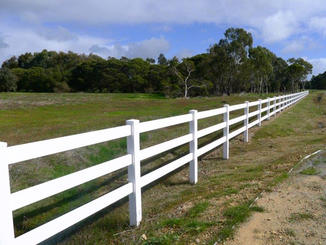We are professional China Custom Vinyl Fence Manufacturers with fences virgin PVC/Vinyl material and UV Protected.
Horse racing and training facilities rely heavily on the design, durability, and safety of track infrastructure. One critical component of this infrastructure is the horse track rail. Horse track rails serve not only as boundary markers but also play a key role in ensuring safety for horses and riders. A common question among track managers, owners, and facility planners is: **“Is horse track rail suitable for both dirt and turf tracks?”
Understanding Horse Track Rail
A horse track rail is a barrier installed along the perimeter of a racetrack. Its main functions include:
- Safety: Preventing horses from leaving the track and reducing the risk of collisions.
- Guidance: Providing a visual and physical reference for horses and jockeys during races or training.
- Durability: Withstanding the repeated impacts of horses, equipment, and environmental conditions.
Horse track rails are typically made from materials such as PVC, vinyl, or metal. Each material offers different advantages in terms of flexibility, maintenance, and adaptability to specific track surfaces.
Dirt Tracks vs. Turf Tracks
Before discussing suitability, it’s essential to understand the differences between dirt and turf tracks.
Dirt Tracks
- Composed primarily of sand, clay, and silt mixtures.
- Require frequent maintenance to maintain a consistent surface.
- Can become compacted or loose depending on weather conditions.
Turf Tracks
- Covered with grass or synthetic turf.
- Provide a softer surface for horses, which can reduce stress on their joints.
- Sensitive to moisture and require specialized drainage systems.
Both types of tracks impose different demands on the fencing system. Therefore, the selection of horse track rail must consider track surface, environmental exposure, and the nature of horse activity.

Key Considerations for Horse Track Rail
1. Material Flexibility
Horse track rails must be strong enough to contain horses but flexible enough to reduce injury risk if a horse collides with the rail. PVC and vinyl rails are commonly used because they:
- Bend slightly upon impact, reducing the severity of injuries.
- Resist cracking, splintering, or rusting, which is especially important for dirt tracks where rails may come into contact with water or mud.
- Maintain their structural integrity on turf tracks, where the surface is softer but may require more secure anchoring.
Metal rails, such as aluminum or steel, are also used. While extremely durable, they offer less flexibility, which can increase injury risk if a horse strikes the rail forcefully.
2. Installation and Anchoring
Proper installation is critical for both dirt and turf tracks. Horse track rails must be anchored securely to prevent displacement, which can compromise safety. Considerations include:
- Dirt Tracks: Rails should be anchored deep enough to remain stable in loose soil while allowing some movement under impact.
- Turf Tracks: Rails need to avoid damaging the grass or root system, so specialized spikes or brackets may be used.
Installation methods differ slightly depending on whether the track is permanent or temporary, but both require careful planning.
3. Maintenance Requirements
Maintenance is another factor that determines suitability. Horse track rails should require minimal upkeep to ensure consistent safety standards:
- PVC and Vinyl Rails: Generally low-maintenance. They resist weathering, rot, and corrosion, making them suitable for both dirt and turf tracks.
- Metal Rails: Require periodic painting or rust treatment, especially in wet climates. Dirt tracks may accelerate wear due to abrasive soil particles.
A rail system that is easy to maintain is particularly beneficial for facilities that host frequent races or training sessions.
4. Visibility
High visibility is essential to prevent accidents. Rails can be designed in bright colors or with reflective coatings to ensure they are easily seen by jockeys and horses:
- On dirt tracks, dust and mud can obscure visibility, so bright-colored rails are preferred.
- On turf tracks, green surroundings may camouflage rails, so contrasting colors such as white or yellow improve visibility.
5. Safety Features
Modern horse track rails can include additional safety features:
- Rounded edges to reduce impact injuries.
- Flexible mounting brackets to allow controlled deflection if a horse hits the rail.
- Breakaway sections for emergency situations.
Both dirt and turf tracks benefit from these features, though turf tracks often require more consideration for rail stability without damaging the grass.
Practical Applications: Are Horse Track Rails Suitable for Both Surfaces?
Based on the above considerations, high-quality horse track rails—especially those made from PVC or vinyl—are suitable for both dirt and turf tracks. Here’s why:
- Versatility: They can adapt to the slight unevenness of dirt tracks and the softer, grassy surface of turf tracks.
- Durability: UV-protected PVC or vinyl resists weathering, making it effective in outdoor environments exposed to sun, rain, or snow.
- Safety: Flexible materials reduce injury risks across different track types.
- Maintenance: Minimal upkeep is required, which is beneficial for both high-traffic dirt tracks and sensitive turf tracks.
However, it is essential to consider local climate, track usage, and horse activity levels when choosing specific rail designs or materials.
Conclusion
Horse track rails are a crucial component for the safety and functionality of both dirt and turf racetracks. Modern materials such as PVC and vinyl make rails versatile, durable, and low-maintenance, making them suitable for multiple track surfaces. Proper installation, visibility, and maintenance are critical to ensuring their effectiveness.
By understanding the differences between dirt and turf tracks, and by selecting the right material and design, track owners and managers can ensure a safe and reliable racing environment for both horses and riders. Whether you operate a training facility or a professional racing venue, investing in high-quality horse track rails is a decision that enhances both safety and performance.
 English
English  中文简体
中文简体
























